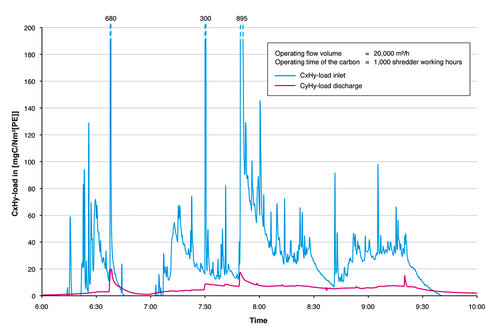Author: Martin Dörner, Ventilatorenfabrik Oelde GmbH
Car shredder plants crush up to 300 tonnes of scrap an hour – vehicles as well as mixed scrap and white goods. Depending on the material, volatile hydrocarbons (Volatile Organic Compounds VOCs) are released in the exhaust air. VOCR, a new system for car shredders developed by Venti Oelde, reduces environmentally damaging hydrocarbon compounds contained in the exhaust air.

Wet scrubbers are usually used for the required cleaning of and reduction of pollutants in the exhaust air. These are, however, limited in their ability to remove the harmful hydrocarbons. Venti Oelde now offers, with its VOCR system (Venti Oelde Carbon Reduction), an alternative which is both effective and economical, as an upgrade or new installation.
The statutory framework
Hydrocarbon compounds carried in the exhaust air are regarded as precursors of ground-level ozone. The reduction of these VOCs is regulated by the EC Directives (1996/61, 1999/13 und 2001/81). The German law (39th Federal Pollution Control Ordinance on the basis of §48 Federal Pollution Control Act) with the Technical Instructions based on this (Technical Instructions on Air Quality dated 24/07/2002) complies with these directives. In Germany, therefore, a limit value of 50 mg/m³ applies for organic hydrocarbons.
The directive of the European Community has so far been interpreted variously in different EU countries. In the medium term, however, stringent uniform standards for the reduction of hydrocarbon compound emissions from car shredder plants must be expected Europe-wide.
Current Status
In the past this subject, in relation to car shredder plants, has been approached by operators from different directions – even in Germany. In research lasting several years, Venti Oelde tested, analysed and evaluated established processes. These ranged from various thermal oxidation and catalytic oxidation types of secondary combustion, the injection of water into the shredder, the use of dry-type filters with additives, to the addition of liquid or gaseous oxidants to the scrubber water. Adsorption processes were also considered.
Based on these, following specifications for exhaust air systems in car shredders were defined:
The limit values specified in the Technical Instructions on Air Quality must be complied with.
The severe operating conditions in a scrapyard necessitate a system as simple and low-maintenance as possible.
Installation in a new plant and upgrading should both be options.
Investment and operating costs must be reasonable.
VOCR – the best technology
Information gained from the test set-ups argues for a sorption process using activated carbon. This is an effective, environmentally friendly and, simultaneously, economical method of reducing the gaseous hydrocarbon compounds in the shredder exhaust air. For over a year now, Venti Oelde has been operating a test plant on a large scale, which has confirmed this assessment and which has been substantiated by the reliable and trouble-free operation.
The company now offers this process in the form of the VOCR system. It promises two economical and reliable solutions: one as an upgrade for existing plants with wet scrubber and one for new plants without wet scrubber.

VOCR – upgrading plants with wet scrubber
To undertake the upgrade Venti Oelde builds on the already existing wet scrubbers. An advantage of wet scrubbers is that their design is such that they have no components which can be destroyed in an explosion. The properties of existing wet scrubber plants are optimized by Venti Oelde in three steps:
• In Step 1, the residual dust level of the wet scrubber is first reduced to below 10 mg/m³ and, at the same time, the relative air humidity lowered. The residual dust level and the relative air humidity downstream of the scrubber would otherwise be too high, the carbon bed would quickly become clogged, become air-impermeable and the result would be sooting.
• Basically, the plant must be sufficiently robust to withstand explosions caused by liquid vapours or crushed gas-bottles. In Step 2, therefore, the activated carbon adsorber is decoupled with regard to pressure. To achieve this, an additional centrifugal fan actively draws the exhaust air from the open stack, so that any pressure wave can escape upwards without hindrance. An explosion vent is provided in front of the centrifugal fan, through which the residual pressure can be released, removing any explosion hazard. The CO levels and the temperature of the shredder exhaust air as well as the temperature in the activated carbon vessel are recorded and analyzed. An active decoupling of the activated carbon adsorber is ensured in the same way as CO2 extinguishing is.
• In Step 3, finally, the fine dust is captured. A filter-box is mounted in front of the standardized activated carbon vessels. It protects the activated carbon in the vessels from dust. A differential pressure monitor indicates when the filter fabric needs to be replaced.
Depending on type, operating times, exhaust air volume and hydrocarbon loading, this procedure will provide a lifetime of between six and over twelve months. The pilot plant, with a volume flow of 20,000 m³/h, easily reached 1,000 operating hours. The activated carbon which is not yet spent can continue to be used. The system adsorbs hydrocarbon compounds until the carbon becomes spent. Once the activated carbon becomes spent the whole adsorber vessel is exchanged and removed. The spent carbon can be reactivated and re-used multiple times.
VOCR – for new plants
When a new dust collection plant is being planned for a car shredder Venti Oelde deviates from the normal procedure of using wet scrubbers and, instead, uses specially designed round filters.
This technology scores on the following points:
• Safety – measures taken to ensure pressure decoupling prevent a carry-over of gas into the filter housing; fire protection is ensured through spark detection and extinguishing plant.
• Economy – a fabric filter reduces energy consumption; separate filter-boxes in front of the activated carbon vessels are redundant and the disposal of waste water and sludge no longer applies. That makes dust collection using a round filter clearly more cost-effective.
• Readiness for the future – more stringent emission levels can, where required, be achieved using other filter materials. Additives, used with particularly oily shredder pre-material, also lend themselves to optimization.

Conclusion
As well as the technical advantages, there are also business considerations which favour the Venti Oelde VOCR system. This applies both to modernization and new plants.
The limit value specified in the Technical Instructions on Air Quality is complied with. Hydrocarbons are distinctly reduced, the quality of the exhaust air is considerably improved. The process is functional, economical, uncomplicated and requires little maintenance. Operating costs are reduced by reactivating the spent carbon, and when non-critical scrap is being processed a bypass-operation can be used. Furthermore, the modular concept of the system means it can be adapted to the exhaust air flow volume. The addition of further components (e.g. water injection into the shredder or, in individual cases, air recirculation to the shredder) can further increase the useful life of the activated carbon.
The modular design means short planning time and flexible arrangements. The standardized activated carbon vessels can be easily exchanged. The system can also be used with other exhaust air flows with "lower" hydrocarbon loads.

关注万迪欧德公众号

万迪欧德抖音号
Copyright © 2022-2023 Venti Oelde (Jiangsu) Air Handling Equipment Co. Ltd All Right
备案号:ICP 2023002554 技术支持:镁诚科技